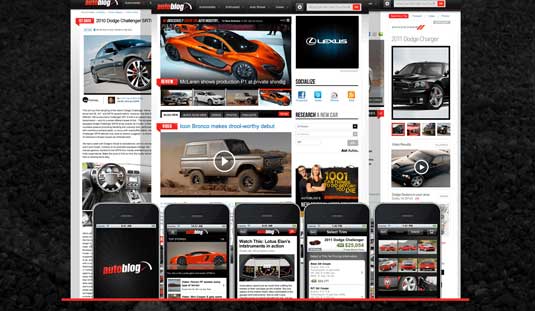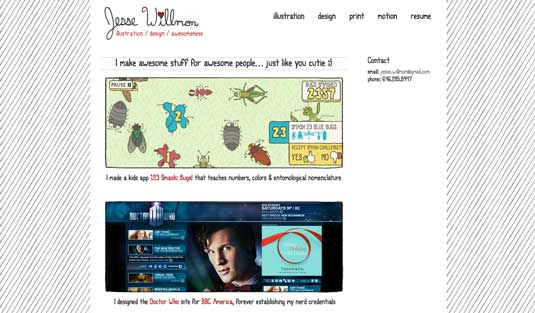5 things your portfolio must have
Senior creative director Jason Cranford Teague reveals the top things you should consider when crafting your portfolio.
When I'm thinking about hiring you for a web design or development job, I don't care where you went to school, what your GPA was, or even what skills you say you have. I don't even really care that much about where you have been working the past few years. What I care about is seeing what you have done, i.e. your portfolio.
Whether it's a resume sent to me by HR, an email from a friend, or a business card handed to me at a conference, I immediately look for that URL which will show me your body of work.
Oh, I may go back and glance at those other things after looking through your portfolio, but if you don't grab me with your portfolio, then I'll move on to the next candidate without so much as a backwards glance.
The kitchen sink approach will not work with your portfolio. You have to carefully consider what goes into your portfolio and the message you are giving. Your portfolio is susceptible to all of the same design considerations as any information based website, and you need to consider your content strategy very carefully.
01. Only the best will do
Bring your A-game material only. You want the viewer to come away as impressed as possible with everything you show them. This means dropping any projects that are not presenting your skills in the best light possible.
It takes less than a second for people to make up their minds about whether they like what they are experiencing, and that's how long you have to grab your viewer. This means that you want show the best parts of what you do immediately. If what you are showing is an extensive user interface, focus on the visually interesting pieces up front, slowly revealing the bits that are possibly more technically difficult after you have their attention.
02. Less is more
Along with #1, quality beats quantity every time. In fact, even if you have fifty A-level projects, focus on the top five to eight, with the others being included only as back-up. Overwhelming your audience with too many choices can turn them off more quickly than too little work (TLDR = Too Long, Didn't Read).
Daily design news, reviews, how-tos and more, as picked by the editors.
Whoever is looking at your portfolio is likely looking at many other portfolios; try to respect their time and show them the important stuff up front to get their attention. If they want to delve deeper into your oeuvre, give them access, but let them make the choice rather than forcing them to weed through everything.

03. It's Alive, ALIVE!
Several of the best projects I have created were "blue sky" ideas that never got built. They were cool. They were innovative. They are not in my portfolio. Saying, "We did this cool thing and it never saw the light of day," always sounds really lame no matter how you phrase it.
You can include projects that have been subsequently replaced by newer work, but these should come further down in your list, and are best if you can at least show a working demo version.
04. Explain your work, but don't embellish
It's not enough just to show your pretty work, you need to explain your role in the project. Unless you are a UX team of one, it's likely that you worked on some of the samples in your portfolio with others. Take the time to explain your role in the project, what you contributed, and how you made things better.
Don't embellish, because you will probably have to elaborate later during the interview. If the person interviewing you detects hyperbole, they'll drop you like a hot potato. Just be honest, and you'll be fine.

05. Tell Your Story
It's easy enough to put together a lot of unrelated work samples with explanations and let them go, but the most effective portfolios will tell your story, how you have developed, what you have learned, and how you are a better designer today than yesterday. This is not an easy task.
Telling your story requires you to think carefully about numbers one, two and three to get the right balance and explanations in place. The best portfolios, in fact, will weave the presented work into an overall narrative, using each piece to support larger points, inverting the typical project based portfolio structure.
This means you will have to think a bit more about the structure of your portfolio site, but it will be worth it.

Words: Jason Cranford Teague
Jason Cranford Teague is a senior creative director at Capital One. He will be speaking this summer in Barcelona at WebVisions and is available for professional training through Rosenfeld Media.
Like this? Read these...
- The designer's guide to working from home
- How to start a blog
- Download the best free fonts

The Creative Bloq team is made up of a group of art and design enthusiasts, and has changed and evolved since Creative Bloq began back in 2012. The current website team consists of eight full-time members of staff: Editor Georgia Coggan, Deputy Editor Rosie Hilder, Ecommerce Editor Beren Neale, Senior News Editor Daniel Piper, Editor, Digital Art and 3D Ian Dean, Tech Reviews Editor Erlingur Einarsson, Ecommerce Writer Beth Nicholls and Staff Writer Natalie Fear, as well as a roster of freelancers from around the world. The ImagineFX magazine team also pitch in, ensuring that content from leading digital art publication ImagineFX is represented on Creative Bloq.
